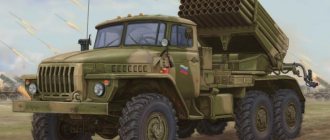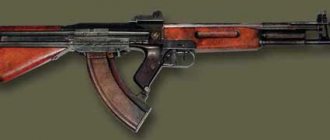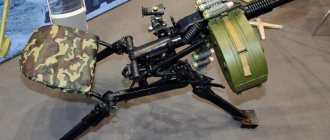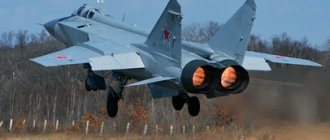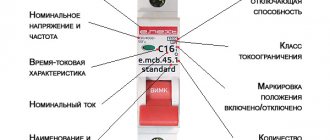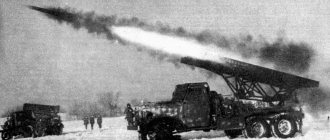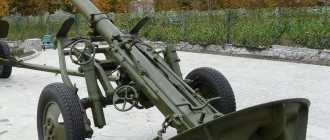BM-13 "Katyusha" on the Studebaker US6 chassis
German self-propelled MLRS Sd.Kfz.4-1 in the Armored Museum in Kubinka
Multiple launch rocket system
(MLRS) - a weapon complex that includes a multi-charge launcher and rockets (unguided rockets, rocket-propelled depth charges), as well as auxiliary equipment, such as transport or transport-loading vehicles and other equipment. MLRS refers to rocket weapons; such systems are in service with the ground forces, air forces and navies of many countries.[1]
The use of a jet engine as part of a rocket virtually eliminates the effect of recoil force when fired, which makes it possible to design simple, lightweight and relatively compact multi-barrel launchers. MLRS launchers can be installed on self-propelled (wheeled and tracked) and towed chassis, airplanes, helicopters and ships. In Russia, self-propelled launchers are called rocket artillery combat vehicles, MLRS launchers installed on airplanes (helicopters) are called launchers, and on ships, they are called rocket launchers (there are ships with conventional MLRS launchers for firing at ground targets). Modern MLRS have a projectile caliber of up to 425 millimeters, a maximum firing range of up to 45 kilometers or more (up to 400 kilometers on some samples), and carry from 4 to 50 rockets, each of which has its own separate guide (rail or tubular) for launching.
The multi-charge nature of the MLRS determines high fire performance and the possibility of simultaneously hitting targets over large areas, which, together with the surprise achieved by salvo fire, ensures a high impact on the enemy. The main disadvantage of rocket artillery systems is the relatively high dispersion of projectiles. In modern conditions, to eliminate this drawback, flight control systems began to be installed on rocket projectiles that correct the trajectory of the projectile (for example, inertial type and inertial, combined with a radio control system at the final part of the trajectory - on the Russian MLRS 9K58 "Smerch" and inertial combined with a satellite system - on GMLRS type projectiles of the American M270 MLRS MLRS).
Story
The multi-charged Korean cart Hwachha, the development of which dates back to the 15th century, during the reign of King Sejong the Great, is called the ancestor of modern MLRS.
The first truly successful attempts at the massive combat use of unguided rockets date back to the beginning of the 19th century, when about 200 gunpowder rockets were fired within half an hour during the British attack on Boulogne in 1806, as well as the so-called “bombardment of Copenhagen” in 1807. They were used in the Anglo-American War of 1812-1815 and during the Napoleonic Wars, however, despite this, the shortcomings of the first missiles led to the fact that by the middle of the 19th century, interest in them as a weapon had significantly decreased.
The revival of unguided rockets as weapons is associated with the development in the USSR by the Rocket Research Institute (RNII) in the period 1927-1937 of RS-82 and RS-132 rockets, which were adopted by the RKKVF. In the summer of 1939, the RS-82 on I-16 and I-153 fighters was successfully used against air targets for the first time in battles on the Khalkhin Gol River. During the Soviet-Finnish War (1939-1940), 6 twin-engine bombers were equipped with launchers for RS-132 missiles. RS-132 missiles were launched against ground targets.
In 1939-1941, the RNII created the BM-13 multi-charge launcher, mounted on a ZIS-6 truck chassis, which was put into service on June 21, 1941, receiving its first baptism of fire in mid-July 1941.
In the post-war period, one of the most famous cases of combat use of MLRS was the massive use of Grad systems by Soviet troops in the Soviet-Chinese border conflict on Damansky Island.
Tornado Strike. Secrets of Russia's most powerful multiple launch rocket system
One of the most powerful types of modern artillery weapons of the Russian army - the Tornado multiple launch rocket system (MLRS) - is expected to be improved in the near future. On November 21, in an interview with the Krasnaya Zvezda newspaper, the Commander-in-Chief of the Ground Forces, Colonel General Oleg Salyukov, said that the troops are planning to receive Tornado-S with increased characteristics in range and accuracy of fire and an expanded range of rockets of increased power.
Work to increase the efficiency of this MLRS is being carried out at the famous Tula enterprise NPO Splav (part of the Tekhmash concern of the Rostec state corporation). It is here that world-class weapons are created, thanks to which Russia remains the best developer of multiple launch rocket systems in the 21st century.
Since the time of the famous Katyushas, designers of domestic MLRS have been able to achieve the power of their use that is almost comparable to the impact force of nuclear warheads. That is why the modified installations “Tornado-G” and “Tornado-S” received their “names” in honor of one of the most destructive natural elements. Without any exaggeration, they can be considered the pinnacle of the rocket artillery of our army.
“Smerch” and “Grad” were replaced by “Tornado”
In 2020, Deputy Minister of Defense of the Russian Federation Yuri Borisov, who was then responsible in the military department for the supply of new weapons, on the Zvezda TV channel, called domestic multiple launch rocket systems one of the most effective and in demand MLRS systems in the world. “In terms of mass production and export capabilities, after the Kalashnikov assault rifle, this is one of the most popular weapons that are bought almost all over the world and are used in all known recent military campaigns,” he said. In 2017–2018 alone, the Tekhmash concern signed contracts for the supply of MLRS worth about $300 million.
Today, American, Turkish, and Chinese companies are well represented on the market; Serbia is showing some success. But still, Russia remains at the forefront in this area, ahead of many. If potential developers of MLRS to increase the range follow the path of increasing the caliber, then Russian gunsmiths solve this problem through technical improvements, increasing the firing range several times.
Approximately 28% of the world market for MLRS of various calibers belongs to our country. First of all, these are the well-known systems “Grad” (caliber 122 mm) and “Smerch” (caliber 300 mm). The first, in various modifications, is in service in 64 countries around the world and is one of the most recognizable types of military weapons.
The BM-21 Grad (based on the Ural truck), adopted by the Soviet army in 1963, surpassed in efficiency all domestic and foreign MLRS of that time. Over 55 years of experience in operation and use in various conflicts, it has confirmed its high reliability and ease of operation. The field rocket system has become the basis for a number of other domestic systems for firing unguided rockets of 122 mm caliber, such as “9K59 Prima”, “9K54 Grad-V”, “Grad-VD”, light portable rocket system “Grad-P”, 22 -barrel ship "A-215 Grad-M", "9K55 Grad-1", BM-21PD "Damba", and some foreign systems, including RM-70, RM-70/85, RM-70/85M, Type 89 and Type 81.
The Grad was replaced by the 9K51M Tornado-G in the Russian army in 2014. Also, according to the military’s plans, the re-equipment of rocket artillery brigades from long-range Smerch systems to modernized large-caliber Tornado-S systems should be completed by 2020. The modification, aimed at maximum automation of fire, represents a further development of the Smerch and will enter service in 2020. The contract for the supply of this system and new missiles for it was signed at the Army 2016 forum. In 2015, the MLRS passed state tests.
As the information and analytical agency Jane's learned during the international forum "Army 2018", the Western and Southern military districts have already received the Tornado-G. “The Armed Forces are also receiving 1B198 control points associated with this MLRS: for example, an artillery unit in the south of Russia received 1B198 in early March 2020,” a source in the military-industrial complex told the publication.
At the end of October, as part of a state defense order, 15 Tornado-G systems were supplied to a motorized rifle unit of the Central Military District stationed in the Samara region.
New precision weapons?
By the way, it was “Smerch” that turned out to be the first most accurate multiple launch rocket system. It is believed that by the standards of rocket artillery it has sniper shooting - the projectile hits the target with an accuracy of up to 300 m. The range of use is 70 km. However, the new ammunition has a range of up to 90 km, and in the future it can fire at 120 km. According to experts, one Smerch can replace approximately 20 Grad installations. That is why the combat power of its successor, the Tornado-S, is often compared to nuclear weapons.
A full salvo of this system is comparable and is the second in terms of indicators after the use of nuclear weapons. "Tornado-S" delivers several tons of explosives to the target, and a full salvo covers an area of 67.6 hectares, where practically nothing remains capable of resisting Vitaly Khomenok, general designer of PJSC "Motovilikha Tornado-S" in Perm at the enterprise "Motovilikha Tornado-S" "is a new automated guidance and fire control system that allows you to simultaneously control the division's fire, as well as automatically calculate target data. The use of the new system will significantly increase shooting accuracy and reduce the time it takes to deploy the complex from the traveling to the combat position.
The MLRS consists of rockets and three vehicles: a combat vehicle (with a launcher), a transport-loader and a command vehicle, from where fire control occurs using an on-board computer. By the way, the technology allows you not to leave the vehicle during salvos; the operator controls the shooting using a remote control. The chassis for the Tornado-S is an 8-wheel all-wheel drive off-road tractor with a wheel diameter of 1.5 m.
"Smart" weapons
As for the Tornado-G, this combat vehicle has significantly greater maneuverability compared to the old model (Grad), but the main difference is in the modern navigation system. Using satellite navigation and computer calculation of ballistic indicators, the system can be aimed at targets in an automated manner.
Now the crew of the combat vehicle, which has been reduced from three to two people, can, without leaving the vehicle, enter flight mission data into the fuses and carry out the launch. In this case, fire can be fired even from an unprepared position, without topographic reference. All this allows, if necessary, to quickly open fire, and then directly from the cockpit move the artillery part of the system to the stowed position and change position.
This speed of maneuver is extremely important in the conditions of modern combat operations and against a serious enemy, whose arsenal includes modern reconnaissance means that can very quickly calculate the coordinates of the point from which a strike is launched. "Tornado-G" can get out of return fire much more effectively than "Grad", and its survivability on the battlefield, according to experts, has increased 4-5 times Vladimir Lepin General Director of Tekhmash
A digital control system and modern communication systems allow the new MLRS to use unmanned aerial vehicles for target reconnaissance, guidance and adjustment of fire. This significantly increases the combat effectiveness of using such a multiple launch rocket system. However, despite this amount of electronics, the Tornado-G has retained the reliability characteristic of the Grad - the machine can be operated at temperatures from -40°C to +50°C with almost 100 percent humidity.
According to the developers, the MLRS is almost four times more powerful than the Grad. Improved projectiles also made it possible to achieve this. The Tornado-G guide package consists of forty launch tubes. The weapon was developed in 122 mm caliber, which also allows the use of standard rockets from the Grad system. However, three new 122-mm projectiles were created for this vehicle, which are striking in their innovation. All ammunition is already being supplied to the troops.
An unguided rocket with a detachable high-explosive fragmentation warhead of increased efficiency (index 9M539) is designed to destroy open and covered manpower, unarmored vehicles, command posts and other targets. According to the developers, it allows you to effectively hit targets behind folds of terrain (reverse slopes, gorges) and in the mountains with a firing range of 5 to 20 km. The destruction efficiency is on average six times higher than that of the 9M22U unguided high-explosive fragmentation projectile, the standard projectile of the Grad system.
An unguided rocket with a cassette warhead with cumulative fragmentation warheads (index 9M541) hits armored targets at a distance of up to 20 km and penetrates armor 140 mm thick. The effectiveness of its destruction is 10 times higher compared to its predecessor.
Another unguided rocket with a high-explosive fragmentation warhead of increased power (index 9M538) is twice as effective as the standard Grad projectile. The mass of the warhead is 34.5 kg, and the number of finished 6-mm submunitions in it reaches 1,312 pieces, 9-mm - 2,660. By the way, this projectile was first presented abroad at the International Defense Exhibition Indo Defense 2020 in Jakarta.
US rating
The American research corporation Research and Development (RAND) included the Russian MLRS "Smerch"/"Tornado-S" and "Grad"/"Tornado-G" in the list of the most effective systems of this class along with the American M270 MLRS/M142 HIMARS and Chinese WS-2.
Details on TASS
See also:
"Tornado", "Chrysanthemums" and "Iskanders". What do the “gods of war” arm themselves with?
From “Katyusha” to “Tornado”: how the jet “gods of war” appeared
A video of the Smerch MLRS reconnaissance drone has appeared
List of MLRS
The Second World War
- Soviet: BM-8-24 (1941), BM-8-36, Katyusha (BM-8–48, BM-13, BM-13N, BM-31-12), M-30
- German: Nebelwerfer (1940), Wurfrahmen 40 (1940), 28/32 cm Nebelwerfer 41/42 (1941/1942), 21 cm Nebelwerfer 42 (1942), 15cm Panzerwerfer 42 Auf.Sf (1942)
- American: T34 "Calliope" (1943)
Post-war
| Caliber | MLRS with fixed guides | MLRS with replaceable packages |
| 105 mm | Pampero | |
| 110 mm | LARS-1, LARS-2 | |
| 122 mm | BM-21 "Grad", Tornado-G, T-122, LAROM, Type 89, Bastion-01, Bastion-02, 9K59 "Prima", RM-70, ZCRS-122, Pinaka, WR-40 Langusta | SR-5, Morava |
| 127 mm | Bataleur | Astros II |
| 128 mm | M-63 Plamen, M-77 "Oga" | Morava |
| 130 mm | Type 82 | |
| 140 mm | Teruel-3, BM-14 | |
| 160 mm | LAR-160 | |
| 180 mm | Astros II | |
| 220 mm | BM-27 Hurricane (Bastion-03), TOS-1 | Uragan-1M, SR-5 |
| 227 mm | MLRS, HIMARS | |
| 230 mm | TOROS | |
| 240 mm | BM-24T, BM-24 | |
| 260 mm | TOROS | |
| 262 mm | M-87 "Orkan" | |
| 273 mm | WM-80 | |
| 300 mm | BM-30 Smerch, Tornado-S, KN-09, A-100, AR1A | Uragan-1M, Astros II, AR-3 |
| 301 mm | Polonaise | |
| 302 mm | WS-1 | |
| 370 mm | AR-3 | |
| 400 mm | WS-2, WS-3 | |
| 425 mm | WS-2D |
Indian Pinaka system
Main characteristics of the system:
- 214 mm ammunition;
- total number of guides – 12 units;
- range – up to 40 kilometers;
- affected salvo area - 130 thousand sq.m;
- the time required to fire a salvo is 44 seconds;
- travel speed – 80 km/h;
- range – up to 850 kilometers;
- the time required for the next salvo is 900 seconds;
- standard calculation – four people;
- weight in combat readiness is almost 6 tons.
Literature
- Angelsky R.
Long-range salvo (Russian) // Equipment and weapons yesterday, today, tomorrow: magazine. - 2003. - March (No. 03). — P. 2-9. - Rastopshin M.
Foreign multiple launch rocket systems (Russian) // Equipment and weapons yesterday, today, tomorrow: magazine. - 2003. - March (No. 03). - pp. 10-15. - Norris, George T.
MRL Around the World.
(English) // Field Artillery Bulletin
. - August 1987. - P. 37-38 - ISSN 0191-975X. (about the development of MLRS in the world) - Halbert, Gerald A.
Development of Soviet Multiple Rocket Launchers.
(English) // Field Artillery Bulletin
. - August 1987. - P. 39-41 - ISSN 0191-975X. (about the development of Soviet MLRS)
Chinese system "WS-1B"
Main characteristics of the system:
- 320 mm caliber ammunition;
- total number of guides – 4 units;
- range – up to 100 kilometers;
- affected salvo area - 45 thousand sq.m;
- the time required to fire a salvo is 15 seconds;
- travel speed – 60 km/h;
- range – up to 900 kilometers;
- the time required for the next salvo is 1200 seconds;
- standard calculation – six people;
- ammunition - three salvos;
- weight in combat readiness is just over 5 tons.
